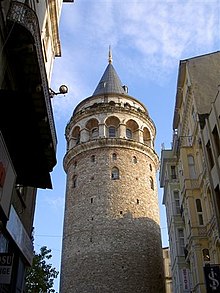Galata Tower


The Galata Tower (Turkish: Galata Kulesi), also called Christea Turris (Tower of Christ) by the Genoese and Megalos Pyrgos (The Great Tower) by the Byzantines, is located in Istanbul, Turkey, to the north of the Golden Horn. One of the city's most striking landmarks, it is a huge, cone-capped cylinder that dominates the skyline on the Galata side of the Golden Horn.

The tower was built as Christea Turris in 1348 during an expansion of the Genoese colony in Constantinople. It was the apex of the fortifications surrounding the Genoese citadel of Galata. The current tower should not be confused with the old Tower of Galata, an original Byzantine tower, named Megalos Pyrgos, which controlled the northern end of the massive sea chain that closed the entrance of the Golden Horn. This tower was on a different site and was largely destroyed during the Fourth Crusade in 1204.
The nine-story tower is 66.90 meters tall (62.59 m without the ornament on top, 51.65 m at the observation deck), and was the city's tallest structure when built. The elevation at ground level is 35 meters above sea-level. The tower has a diameter of 16.45 meter at the base, with 8.95 meters diameter inside, and with walls 3.75 meters thick.
The upper section of the tower with the conical cap was slightly modified in several restorations during the Ottoman period when it was used as an observation tower for spotting fires.
According to the Seyahatname of Ottoman historian and traveller Evliya Çelebi, in 1638, Hezarfen Ahmet Çelebi flew as an early aviator using artificial wings from this tower over the Bosporus to the slopes of Üsküdar on the Anatolian side.
In the 1960s the original wooden interior of the tower was replaced by a concrete structure and it was opened to the public. There is a restaurant and café on its upper floors which commands a magnificent view of Istanbul and the Bosphorus. Also located on the upper floors is a nightclub which hosts a Turkish show. There are two operating elevators that carry visitors from the lower level to the upper levels. Entrance to the tower costs 10 YTL (New Turkish Lira).
